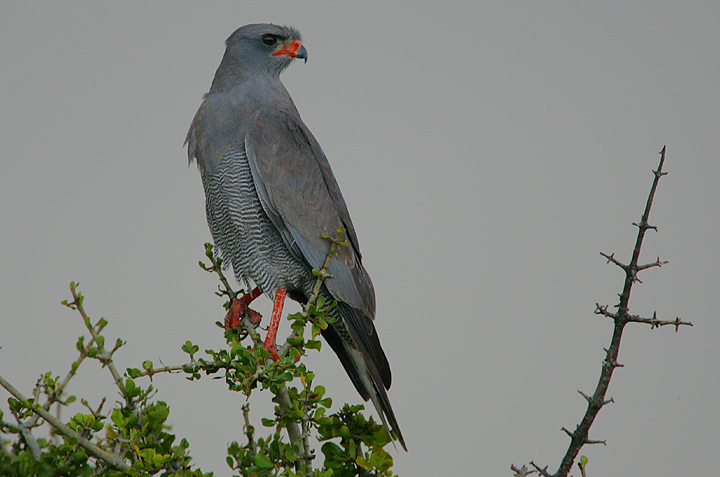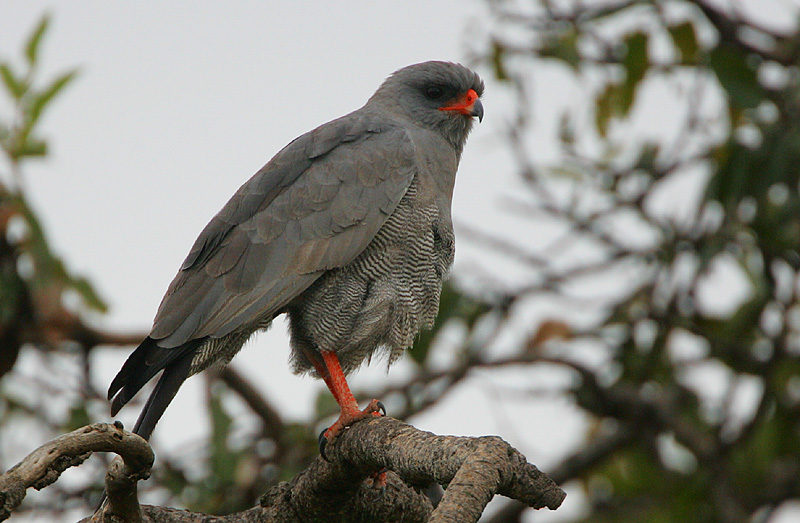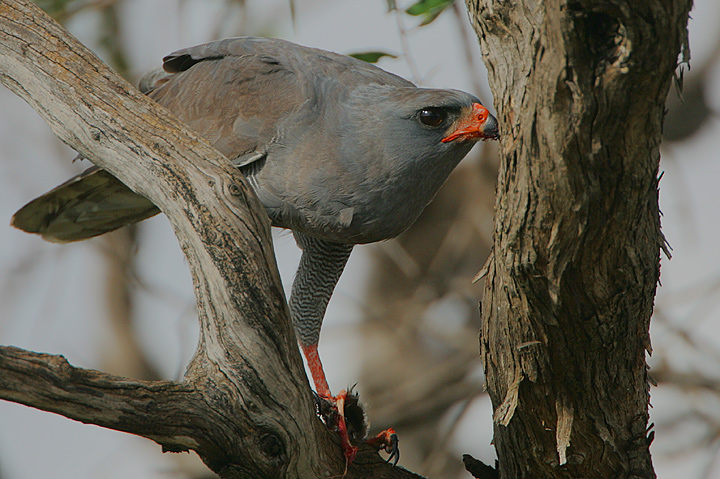
Dark Chanting Goshawk
Melierax metabates
Accipitriforme Order – Accipitridae Family
BIOMETRICS :
Length: 43-56 cm; Wingspan: 92-109 cm; Weight: M: 645-695 – F: 841-852 g
DESCRIPTION:
Dark Chanting Goshawk is a medium-sized raptor with long red legs and grey appearance.

Adult has dark grey upperparts, with slightly paler secondary wing coverts. Rump is white, finely barred with grey. Outer primaries are black, and inner primaries and secondaries are pale grey. Tail is black, with outer feathers barred with white.
Underparts and underwing coverts are white, finely barred with grey. Chest is dark grey. Outer black primaries show pale grey bases, inner primaries and secondaries are pale grey, finely barred with whitish. Tail is barred dark grey and white.
Head is dark grey. Hooked bill is black with red cere and gape. Eyes are dark red-brown. Bare long legs and feet are red.
Both sexes are similar, but female is slightly larger than male. Male has slightly paler wing coverts.
Juvenile has brown upperparts with paler edges. Rump is white, barred with brown.
Underparts are white, with breast streaked brown, and belly barred with brown. Flight feathers and tail are dark brown above. Underwings are white barred with dark, and they are finely barred with brown on secondaries. Tail is whitish, barred with dark brown below.
Cere, legs and feet are orange. Eyes are yellow.
VOICE: SOUNDS BY XENO-CANTO
Dark Chanting Goshawk often calls from a perch or in flight, uttering an accelerating series of piping notes and fluty whistles, almost a song “kleeu-kleeu-klu-klu-klu”. It also gives a high-pitched “kleee-u”. It is very vocal during breeding season.
HABITAT:
Dark Chanting Goshawk lives in savannahs and open woodlands, favouring broad-leafed woodlands, and mixed bushveld.
RANGE:
Dark Chanting Goshawk lives in sub-Saharan Africa, south western Morocco and south western Arabia. Its range may overlap narrowly with that of Southern Pale Chanting Goshawk.

BEHAVIOUR:
Dark Chanting Goshawk hunts from top of bushes, trees or termite-hills, or other poles. When prey is selected, it dives to the ground and catches lizards, snakes, small mammals or birds, and insects. It may chase birds while flying, but it usually hunts on the ground, after its steep, fast dive from its perch. It is an agile raptor.
Dark Chanting Goshawk is usually seen singly or in pairs, often perched for long periods on a prominent perch, such as tree top or utility poles.
During breeding season, Dark Chanting Goshawk performs flight displays, accompanied with melodious whistles from a tree top or in flight.
FLIGHT:
Dark Chanting Goshawk flies with steady, shallow wing beats. It soars with raised wings.
REPRODUCTION:
Dark Chanting Goshawk’s nest is built on an inside main fork of a woodland tree, usually a thorny Acacia. Small nest is made with sticks and soft grass materials.
Female lays one or two eggs, from August to November (February to March in Morocco). Incubation lasts about 36 days, by female. Young fledge at about 50 days of age.

DIET:
Dark Chanting Goshawk feeds mainly on reptiles, small snakes, lizards, chameleons. It also hunts birds as small pigeon, insects and small rodents.
PROTECTION / THREATS / STATUS:
Dark Chanting Goshawk Morocco’s population is endangered. This isolated population is probably sedentary.
This species is a scarce resident in its range, relatively uncommon.
Fr: Autour sombre
All : Graubürzel-Singhabicht
Esp : Azor-lagartijero Oscuro
Ital : Astore cantante scuro
Nd : Donkere Zanghavik
Russe : Ястреб певчий
Sd : Mörk sånghök
Photographs by Steve Garvie
His website:
RAINBIRDER Photo galleries
Text by Nicole Bouglouan
Sources :
HANDBOOK OF THE BIRDS OF THE WORLD Vol 2 by Josep del Hoyo-Andrew Elliot-Jordi Sargatal - Lynx Edicions - ISBN: 8487334156
BIRDS OF PREY OF AFRICA AND ITS ISLANDS by Alan and Meg Kemp - Struik Publishers - ISBN: 1770073698
BIRDS OF AFRICA SOUTH OF THE SAHARA by Ian Sinclair and Peter Ryan - Princeton University Press Princeton and Oxford - ISBN: 0691118159